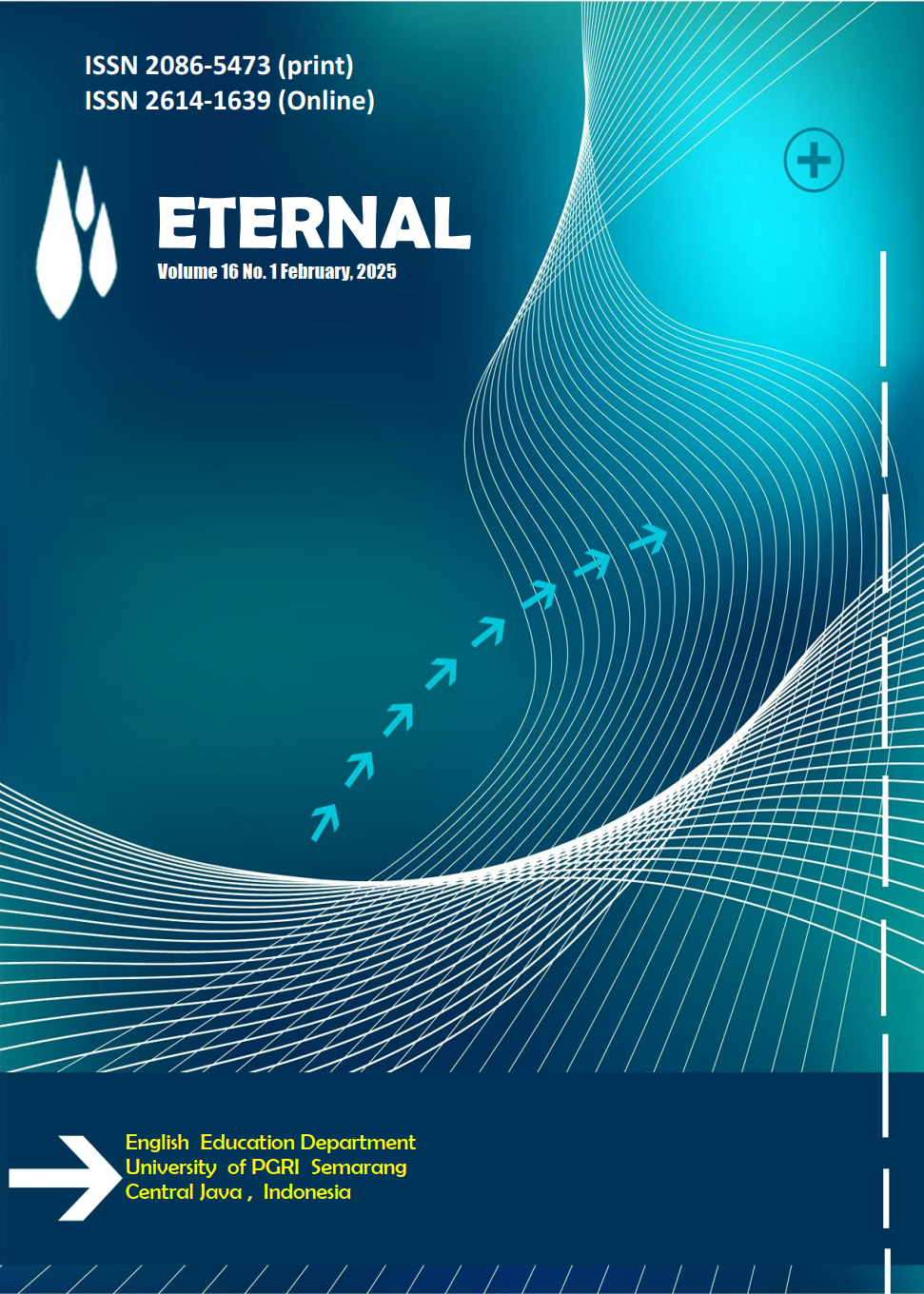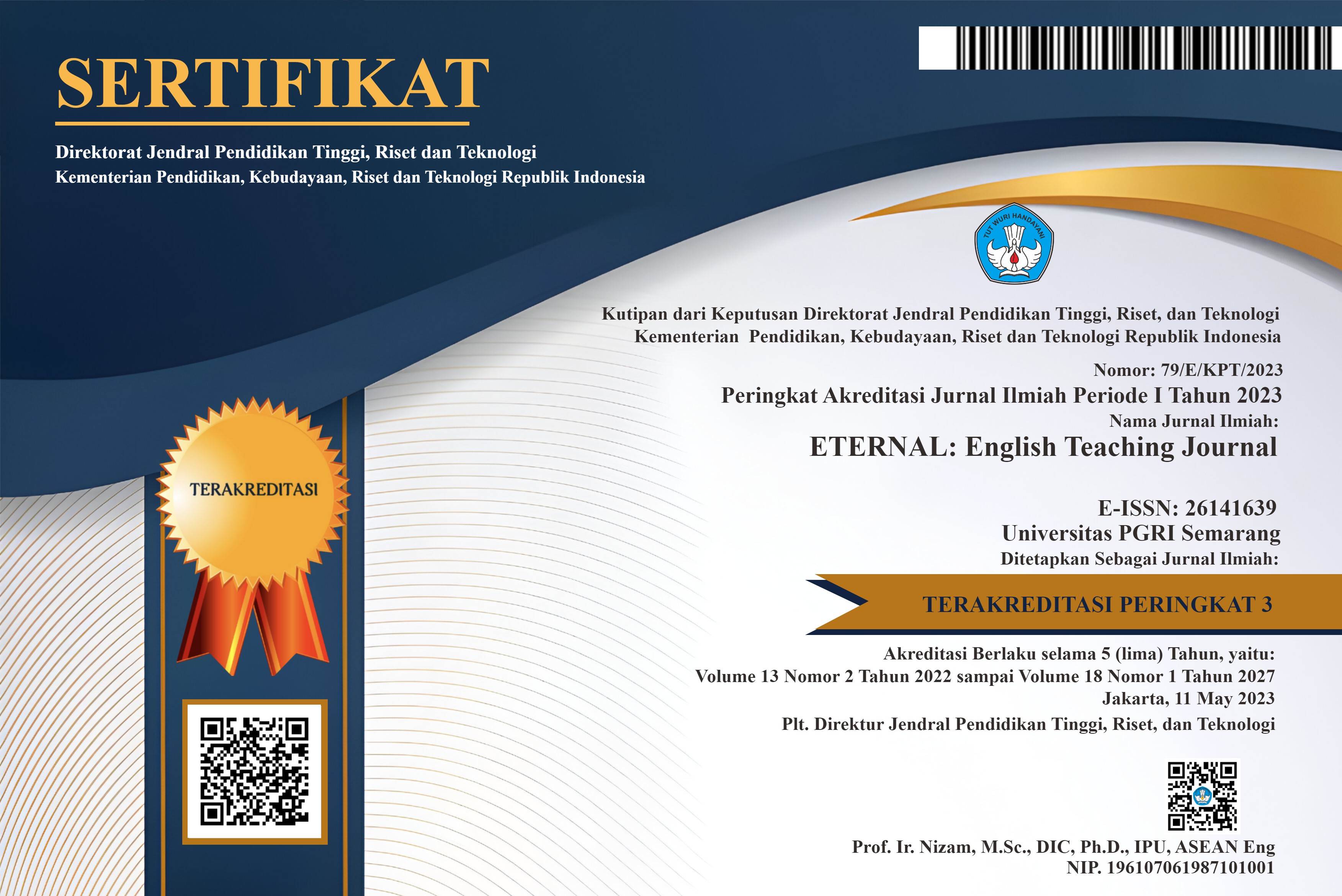The Effect Of Using Question-Answer Relationship (QAR) On Students’ Reading Comprehension Abilities In Procedure Text
DOI:
https://doi.org/10.26877/eternal.v16i2.1905Keywords:
Reading Comprehension, Question-Answer Relationship (QAR) Strategy, Procedure TextAbstract
This research aims to discover how well the students' reading comprehension abilities are enhanced by QAR strategy and to discover how the students’ responses to the use of QAR strategy. The population in this research were students of 10th grade SMK Ma’arif 9 Kebumen which consisted of 507 students and the sample consisted of 60 students. This research used a quantitative and data was gathered from the test result as well as a questionnaire containing 16 questions with an item scale. The test result in experimental class showed that the pre-test average was 55.6 while the post-test was 82.2. The average score of both is quite different. After hypothesis testing was carried out, the results obtained were T Score < T Table (0,000<0,05), Therefore, it can be said that using QAR has an impact on students' reading comprehension abilities of 10th grade students in SMK Ma’arif 9 Kebumen. In addition, the students also showed positive responses to the use of QAR strategy such as the students were able to mark keywords from the text to find the correct answer, the students were able to explain the information contained in the reading text, and the students said that the QAR strategy facilitated them to understand the reading text and to answer the questions. It was evident from the results of the questionnaires. Most of students stated that the QAR technique was highly beneficial and helped them enhance their reading comprehension skills.
References
Abdi, A. R. (2021). The Implementation of Question Answer Relationship (QAR) Strategy in Improving Students’ Reading Comprehension of Descriptive Text. 6.
Abdul Baqi, F. (2019). Implementing Question-Answer Relationships (Qar) Strategy To Improve Students’ Reading Comprehension Skill. English Journal, 13(2), 88. https://doi.org/10.32832/english.v13i2.3832
Adom, D., Mensah, J. A., & Dake, D. A. (2020). Test, measurement, and evaluation: Understanding and use of the concepts in education. International Journal of Evaluation and Research in Education, 9(1), 109–119. https://doi.org/10.11591/ijere.v9i1.20457
Afriani, A. (2021). Teachers Difficulties in Teaching Reading Comprehension During Online Classroom (Issue June).
Al Aziz, E. N., & Yusanti, G. (2020). Increasing Students’ Reading Comprehension Skill By Using Written Text Book. English Education : Journal of English Teaching and Research, 5(2), 179–186. https://doi.org/10.29407/jetar.v5i2.14500
Alfisyahrin, R. (2022). The Implementation of Prediction Strategy In Improving Students’ Reading Comprehension In English Recount Text. 9, 356–363.
Anggraini, D. (2021). Question-answer relationship (QAR) as a strategy training to improve students’ reading comprehension of narrative text. Journal Maintenance, 09(02), 161–169.
Anyiendah, M. S., Odundo, P. A., & Kibuyi, A. (2020). Prediction Skills, Reading Comprehension and Learning Achievement in Vihiga County Kenya. Addressing Constraints and Prospects. English Language Teaching, 13(10), 139. https://doi.org/10.5539/elt.v13n10p139
Arsyad, R., Hidayahni Amin, F., & Nurdiana, N. (2022). Penggunaan Strategi Question Answer Relationship (Qar) untuk Meningkatkan Kemampuan Pemahaman Membaca Peserta Didik pada Kelas XI MAS Muhammadiyah. Jurnal Pemikiran Dan Pengembangan Pembelajaran, 4(2), 231–238.
Astuti, Y. (2021). The Implementation Of Question Answer Relationship (Qar) In Improving Students’ Reading Comprehension Thesis. 6.
Azzahra, M. Z. (2020). The Effectiveness Of Question-Answer Relationship (Qar) Strategy On Students’ Reading Comprehension Of Explanation Text Presented to the Faculty of Educational Sciences in Partial Fulfillment of the Requirements for the Degree of S.Pd. (S-1) in English Ed.
Chin, A. S. W., & Ghani, K. A. (2021). The Use of Think-Aloud in Assisting Reading Comprehension among Primary School Students. Journal of Cognitive Sciences and Human Development, 7(1), 11–32. https://doi.org/10.33736/jcshd.2456.2021
Concannon-Gibney, T. (2019). Listening and reading comprehension. Teaching Essential Literacy Skills in the Early Years Classroom, 88–114. https://doi.org/10.4324/9781351061193-5
Creswell, J. W. (n.d.). Research Design.
Fisher, A. (2016). Techniques Difficulties in Recount Text. Journal of English and Education, 4(2), 1–12.
Gedik, O., & Akyol, H. (2022). Reading Difficulty and Development of Fluent Reading Skills: An Action Research. International Journal of Progressive Education, 18(1), 22–41. https://doi.org/10.29329/ijpe.2022.426.2
Hidayati, D. (2018). Students Difficulties in Reading Comprehension At. Students Difficulties in Reading Comprehension At.
Khoeru Solihin, R., & Muaz, M. (2022). the Use of Question Answer-Relationship (Qar) Strategy on Improving Students’ Reading Comprehension At Sman 1 Jatitujuh. Journal of English Language Learning, 6(1), 115–120. https://doi.org/10.31949/jell.v6i1.2747
Muzammil, S. (2017). Qar (Question Answer Relationship) As an Alternative Strategy To Teach Reading. JL3T ( Journal of Linguistics Literature and Language Teaching), 2(2), 101–123. https://doi.org/10.32505/jl3t.v2i2.17
Nimah, F. E. (2022). the Effectiveness of Scanning Technique in Teaching Reading.
Ningsih, S. (2017). Improving the Students ’ Ability in Reading.
Nurdiana; Amelia, R. (2017). Interpretive Reading.
Palone Zanatta, M. M. (2021). Teaching Reading Techniques and Strategies EnglishLanguage.90–101. https://doi.org/10.33422/2nd.worldcte.2021.01.09
Rahmawati, M. R., Listiyani, A., & Damayanti, S. (2017). The Problems Encountered by Teachers in Teaching Procedure Text Movi Riana Rahmawati, Anni Listiyani and Sri Damayanti English Education Study Program Ibn Khaldun University of Bogor. English Journal, 8(1), 45–55.
Sani, R. D., & Asty, H. (2021). Students’ Writing Ability In Generic Structure Of Procedure Text In SMK Padang. Jurnal Pendidikan Nasional, 1(2), 40–45. https://doi.org/10.55249/jpn.v1i2.7
Sharma, H. (2022). How short or long should be a questionnaire for any research? Researchers dilemma in deciding the appropriate questionnaire length. Saudi Journal of Anaesthesia, 16(1), 65–68. https://doi.org/10.4103/sja.sja_163_21
Sholichah, N. I. (2015). The Implementation of Question-Answer Relationship (QAR) Strategy in Teaching Reading of Narrative Text for Tenth Grader of Man Mojokerto. Retain, 1–6. https://jurnalmahasiswa.unesa.ac.id/index.php/43/article/view/12330%0Ahttps://jurnalmahasiswa.unesa.ac.id/index.php/43/article/download/12330/11395
Soraya M. (2017). The Effect of Question-Answer Relationship (QAR) and Think Aloud Strategies on Reading Comprehension Ability. Faculty of Tarbiyah and Teacher Training Ar-Raniry State Islamic University Darussalam-Banda Aceh, 231.
Ummah, M. S. (2019). Improving Students’ Reading Comprehension Of Recount Text Through Question Answer Relationship (Qar) Strategy. Sustainability (Switzerland), 11(1), 1–14. http://scioteca.caf.com/bitstream/handle/123456789/1091/RED2017-Eng8ene.pdf?sequence=12&isAllowed=y%0Ahttp://dx.doi.org/10.1016/j.regsciurbeco.2008.06.005%0Ahttps://www.researchgate.net/publication/305320484_SISTEM_PEMBETUNGAN_TERPUSAT_STRATEGI_MELESTARI
Wulan Sari, A., & Winona Emelia, T. (2022). The Effect of Question Answer and Relationships (QAR) Strategy Toward the Students’ Achievement in Reading Comprehension of Narrative Text. Jurnal Riset Ilmu Pendidikan, 2(3), 143–149. https://doi.org/10.56495/jrip.v2i3.145







